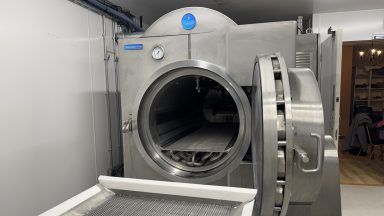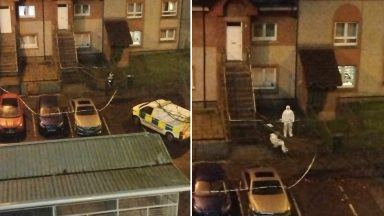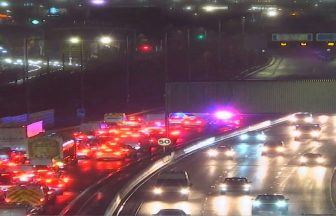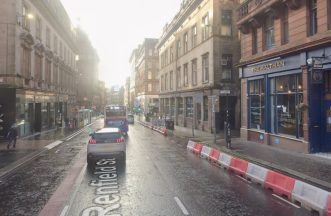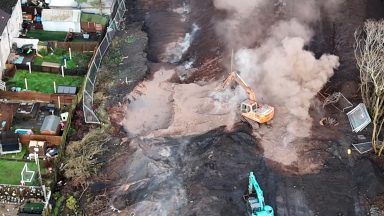The company responsible for a building site where a ten-year-old boy died after falling down a manhole was unaware children had accessed it before they took it over, an inquiry heard.
Shea Ryan died on July 16, 2020 when he climbed through an unsecured fence on a building site in Drumchapel, Glasgow, and fell 20ft down a manhole shaft.
David Swanney, representing Shea’s mother Joanne Ferguson, opened the second day of a Fatal Accident Inquiry (FAI) at Glasgow Sheriff Court by questioning Robert Van Beek, who had been contracts manager with construction firm RJ McLeod at the time of the incident.
Mr Swanney asked the 62-year-old about the area of the site where the Scottish Water manhole in which Shea died – which was known as MH22 – was located.
He explained it was on an area of the site known as the Garscadden Burn Area (GBA) which had been operated by a company called ABV until July 3, 2020, when RJ McLeod, which had been putting in drainage works at the rest of the site since March, took on responsibility for it.
Mr Swanney told the inquiry it was “a matter of public record” there had been five reports of unauthorised access on the GBA between April and June, before RJ McLeod took it over.
He told the inquiry on one occasion on May 20, a report by site security contractors Prime Security stated fence panels at a play park next to the site had been “pushed over”, and CCTV had filmed youths on the site.
On another occasion on June 13, he said, two youths were caught on CCTV standing on top of earth-moving vehicles.
On the last reported incident on June 17, he said, the site security guard reported having come under attack from children aged between five and 13, who were throwing stones at him and trying to set fire to his jacket.
According to the report, he said, this was a “nightly occurrence” and two members of the public had to intervene to help the man.
Mr Swanney reminded Mr Van Beek that RJ McLeod had implemented extra security measures after Shea’s death, and asked him: “If you were aware of the unauthorised access incidents between April and June 2020, you would have implemented those measure before you took over the site on July 3?”
Mr Swanney replied they would have put in “a more active form of security” involving CCTV cameras and additional fencing, as the GBA would have been considered “high risk”.
Mr Van Beek told the inquiry he had met the site manager to discuss security arrangements for GBA a few weeks before the takeover, and that he also visited the site on July 2.
He said he had checked the fences during that visit, and that “all the fencing was double-clipped as far as I could see, and there were no panels missing”.
Sheriff Stuart Reid asked whether he had seen the Scottish Water manholes, including MH22, during any of his visits to GBA and he said: “I don’t recall.”
He explained that the Scottish Water manholes on GBA were part of a different drainage system from the one RJ McLeod was working on, and that their work “didn’t involve accessing MH22, which had nothing to do with it”.
Sheriff Reid asked him whether “RJ McLeod staff had any reason to access MH22 for the purposes of their work at GBA?”
“No,” Mr Van Beek said, “unless they wanted to check the depth,” adding it wouldn’t have been unusual to check conditions across the whole site.
Mr Van Beek added that, at the time of the handover, he had thought the manholes were finished, and it was company policy to cover unfinished manholes with a “ballast bag” weighing between half-a-tonne and a tonne, which he said could be “taken off if there’s more work to do”.
Mr Van Beek also told the court he did not know whether ABV had been specifically asked about instances of unauthorised access prior to the handover, explaining that he had not been at the meeting with them.
He was asked by procurator fiscal depute Nicola Gillespie whether RJ McLeod should have done an additional risk assessment when taking over a new area of the site anyway, given it had not been covered by their original construction phase plan where security arrangements were set out.
Mr Van Beek acknowledged that “with the benefit of hindsight, yes,” but added that he did npt know “every single risk assessment that was done”.
Mr Swanney then asked Mr Van Beek about “any other cases of unauthorised access” at the GBA between the point they took it over on July 3 and Shea’s death, adding there had been a report of side windows having been smashed on an 18-tonne site vehicle, a camera stolen and a fence panel “trashed”.
Mr Van Beek responded that, at the time, he had only been aware of the smashed windows, and the only area of particular concern had been at a point on the site known as Bund B, where a footpath through the site had been fenced off.
He said the fences at this point were regularly damaged and, on one occasion before July 3, “we had an incident of trespassing overnight, fences were pulled down”.
Following this, he said, the company reinforced the area with timber stakes and ropes, “to reduce the likelihood of the fences being pushed over or pulled over,” and that while the panels were subsequently damaged there was no evidence of unauthorised access after this.
He said when taking over the GBA the company installed triangular fencing along the footpath through the site, which “per the contract” they had to keep open, to make it “more robust”.
However, he said a play area off the footpath only had single fencing, telling the inquiry: “We didn’t make any special arrangements or measures in relation to that swing park other than the general fencing we had in that area.”
Stuart Laurence, the deputy site agent, told the inquiry that staff should have checked manhole MH22 was safe when his firm became responsible for it at the start of July 2020.
A central question in the inquiry has been how Shea was able to access the unfinished manhole in which he lost his life.
Mr Laurence told the inquiry the first time he saw MH22 was after the GBA takeover on July 3: “I know it didn’t have a layer of engineering bricks on it so from that I know it wasn’t finished.”
He said he could see it was just the metal lid on top of the “biscuit”, the metal ring at the top of the shaft on which the lid sits.
He said it would have been “obvious at a glance” whether a manhole was finished or unfinished.
The civil engineer explained an “unfinished” manhole would be covered by a concrete structure with a cast iron lid weighing approximately 80 kilogrammes.
The lid, he said, would need “two guys” to carry it, but that “a grown person could maybe push it”.
He added that he “wouldn’t think” that a 10-year-old child would be able to move it.
He said a finished manhole would have a metal structure concreted in place, topped with a 60-70kg metal lid that required special tools to open.
Asked about whether a risk assessment had been done on MH22 following the takeover, Mr Laurence replied “There wasn’t a risk assessment for the manhole because we didn’t build it.”
Pressed on whether there should have been one, he replied: “In hindsight, yes, there should have been.”
The inquiry continues.
Follow STV News on WhatsApp
Scan the QR code on your mobile device for all the latest news from around the country


 Police Scotland
Police Scotland




